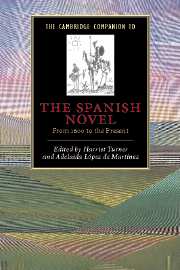Book contents
- Frontmatter
- 1 On the novel: mirror and text
- Part 1 Since Cervantes
- Part 2 The nineteenth century
- Part 3 The twentieth century
- 10 From the Generation of 1898 to the vanguard
- 11 The testimonial novel and the novel of memory
- 12 Questioning the text
- 13 Women and fiction in post-Franco Spain
- 14 Cultural alliances: film and literature in the socialist period, 1982–1995
- 15 The novel beyond modernity
- 16 Writing about writing
- Bibliography
- Index
- Series List
11 - The testimonial novel and the novel of memory
from Part 3 - The twentieth century
Published online by Cambridge University Press: 28 May 2006
- Frontmatter
- 1 On the novel: mirror and text
- Part 1 Since Cervantes
- Part 2 The nineteenth century
- Part 3 The twentieth century
- 10 From the Generation of 1898 to the vanguard
- 11 The testimonial novel and the novel of memory
- 12 Questioning the text
- 13 Women and fiction in post-Franco Spain
- 14 Cultural alliances: film and literature in the socialist period, 1982–1995
- 15 The novel beyond modernity
- 16 Writing about writing
- Bibliography
- Index
- Series List
Summary
When placing works of prose fiction within the framework of modernity, critics find that diverse styles and trends tend to conform to a basic structure, which Nil Santiáñez-Tió has termed a “spectrum of possibilities”:
This spectrum has two poles: the realist pole (transparent language, tendency toward a transparent linguistic code, metonymical structure, unity of structure and subject, temporal organization, relation of subject to his/her biographic and social context, predominance of story over discourse, preference for unity and consistency, tendency to global visions, subordination to the principle of non-contradiction); the experimental, modernist pole (experimental and dislocated language, a dense linguistic code, metaphoric structure, dissolution of personal identity, spatial organization, predominance of fictional discourse over story, a narrative distanced from direct communication, rejection of global visions, epistemological doubt).
In 1983 I proposed that a similar polarity existed between the testimonialnovel, on the one hand, and the poetic novel, on the other. But whether onespeaks of “realist” as opposed to “modernist” prose or of the testimonial asopposed to the poetic novel, it is certainly the case that the idea of literarypolarity derives from what we consider “modern” literature. Both poles maybe present at the same time, in the same writer, and even in the same work.These poles may exist in a relatively pure state or as subtle variations thatcombine the magnetic attraction of one to the other.
- Type
- Chapter
- Information
- The Cambridge Companion to the Spanish NovelFrom 1600 to the Present, pp. 172 - 192Publisher: Cambridge University PressPrint publication year: 2003



